Optimal Dispatch of Wind Power, Photovoltaic Power, Concentrating Solar Power, and Thermal Power in Case of Uncertain Output
Abstract
:1. Introduction
2. Generating Combined Scenarios by Considering Uncertainty in Forecasted Outputs of Wind and Photovoltaic Power
2.1. Derivation of Uncertainty in Predicted Outputs of Wind and Photovoltaic Power
2.2. Generation of Combinations of Typical Scenarios
- (1)
- The curve of the cumulative probability distribution of the random variables is used to generate a plurality of improved forecasts of the outputs of wind and photovoltaic power through Latin hypercube sampling [22].
- (2)
- These improved values are used to calculate the relative error in the predicted outputs of wind and photovoltaic power according to Equation (7) [23].
- (3)
- The error along with the formula is used to generate the predicted outputs of wind and photovoltaic power to form an initial scenario set.
- (4)
- A typical scenario set of the outputs of wind and photovoltaic power is generated by the two-stage scenario reduction method [24].
- (5)
- The Cartesian product is used to varyingly combine the typical scenarios obtained above [7].
- (6)
- The Spearman correlation coefficient is used to determine the complementarity of wind and solar power in the combinations of scenarios, and the scenario with the optimal complementarity is selected.
3. Two-Stage Optimal Model of Dispatch for a Combination of Wind Power, Photovoltaic Power, CSP, and Thermal Power Generation under Multiple Scenarios
3.1. First Stage of Optimization Model
- (1)
- Constraint on wind power output:
- (2)
- Constraint on photovoltaic power output:
- (3)
- Constraint on instantaneous thermal power balance of CSP station:
- (4)
- The equation of the heat energy balance of the heat collection system is:where is the efficiency of photothermic, is the area of the mirror field, and is the hourly direct solar radiation index (DNI).
- (5)
- The constraint on the functional relationship between the input thermal power and the output electric power of the power generation system is as follows:
- (6)
- Constraint on the heat energy balance of the heat storage system:
- (7)
- Another constraint on the heat storage capacity of the heat storage system:
- (8)
- The following are the constraints on the power storage and release of heat in the thermal storage system of the CSP station, where the storage and release of heat cannot be performed at the same time, and the state of heat release is restricted only when the unit is started:where are the maximum heat storage and heat release power of the heat storage system, respectively. are the binary variables of heat storage and heat release, respectively, “1” means that the system is storing heat and “0” means that it is releasing heat, and is the variable of the working state of the CSP station, where “1” means that it has been turned on.
- (9)
- Constraints on the output of the CSP station:where are the maximum and minimum outputs of the CSP, respectively.
- (10)
- Constraints on the minimum start and stop times of the CSP unit:where are the minimum start and stop times of the CSP unit, respectively.
- (11)
- Constraints on the relationship between the variables of the state of operation of the CSP station, and those of the start and stop times are as follows:where are the start and stop variables of the CSP unit, respectively, and “1” indicates that the unit is in the start or stop state.
- (12)
- Constraints on the ramp rate of the CSP unit:where are the upward and downward ramp rates of the solar thermal unit, respectively.
3.2. Second Stage of the Optimization Model
- (13)
- Constraints on the power balance of the system:
- (14)
- Constraints on the output of the thermal power units:where are the minimum and maximum outputs of each thermal power unit, respectively.
- (15)
- Constraints on climbing on thermal power units:where are the downward and upward climbing rates of each thermal power unit, respectively.
- (16)
- Constraints on the minimum starting and stopping times of thermal power units:where is the continuous start-up time of the first thermal power unit, is its continuous shutdown time, is its minimum start-up time, and is the minimum shutdown time of the first thermal power unit.
4. Example for Analysis
4.1. Basic Data and Parameters
4.2. Analysis of Results of Example
4.2.1. Generation of Typical Combined Scenarios
4.2.2. Analysis of Optimal Outputs of Wind Power, Photovoltaic Power, and CSP under Different Typical Combinations of Scenarios in the First Stage
4.2.3. Analysis of the Optimal Outputs under Different Typical Combinations of Scenarios in the Second Stage of Optimization
4.2.4. Analysis of Influence of Complementarity of Wind and Photovoltaic Power on Results of Dispatch
4.2.5. Comparative Analysis of Different Scheduling Modes
4.2.6. Comparison between Relative Error and Absolute Error
5. Conclusions
- (1)
- Aiming at the uncertainty problem of wind and solar prediction output, on the basis of the traditional martingale model, this paper proposes an improved martingale model to analyze the uncertainty of the wind and solar prediction output by replacing the absolute error value in the traditional martingale model with the relative error of prediction.
- (2)
- Through Latin hypercube sampling and two-stage scene reduction technology, a typical wind and solar prediction output scenario is generated. Then, the Cartesian product idea is used to combine the typical scene of the generated wind and solar prediction output. The Spearman correlation coefficient is used as an indicator to quantitatively analyze the complementarity of the wind and solar prediction output in the combination scenario. The combination of the wind and solar prediction output with the best complementarity is selected to form different typical combination scenarios.
- (3)
- A two-stage coordinated dispatch model of wind-solar-thermal combined power generation system under different combination scenarios is established. Different scheduling modes are set for comparison and analysis.
Author Contributions
Funding
Data Availability Statement
Conflicts of Interest
References
- Li, C.H.; Jiang, M.; Yao, D.G.; Ge, H.C.; Zhang, Z.A.; Tang, L. Rolling dispatching method of two-stage reactive power in high proportion renewable energy power system. China South. Power Grid Technol. 2022, 16, 94–103. [Google Scholar]
- Du, E.S.; Zhang, N.; Kang, C.Q.; Shen, M. Reviews and Prospects of the Operation and Planning Optimization for Grid Integrated Concentrating Solar Power. Proc. CSEE 2019, 36, 5765–5775. [Google Scholar]
- Liu, Y. Research on Optimal Dispatch of Multi Source Power Generation System with Electric Heater and Concentrating Solar Power Plant. Master’s Thesis, East China Jiaotong University, Nanchang, China, 2021. [Google Scholar]
- Huang, K.L. Robust Optimization Design for Fatigue Life of a Car Body Based on Weibull Distribution. Master’s Thesis, Jilin University, Jilin, China, 2021. [Google Scholar]
- Li, P.; Guan, X.H.; Wu, J. Wind Power Scenario Generation for Multiple Wind Farms Based on Atmospheric Dynamic Model. Proc. CSEE 2016, 35, 4581–4590. [Google Scholar]
- Tian, Y.Y. Hydropower, Thermal Power, Wind Power and Photovoltaic Joint Dispatch Considering Uncertainty. Master’s Thesis, Xi’an University of Technology, Xi’an, China, 2020. [Google Scholar]
- Zhang, J.T.; Cheng, C.T.; Shen, J.J.; Li, G.; Li, X.F.; Zhao, Z.Y. Short-term Joint Optimal Operation Method for High Proportion Renewable Energy Grid Considering Wind-solar Uncertainty. Proc. CSEE 2020, 40, 5921–5932. [Google Scholar]
- Wang, Q.; Dong, W.L.; Yang, L. A Wind Power/Photovoltaic Typical Scenario Set Generation Algorithm Based on Wasserstein Distance Metric and Revised K-medoids Cluster. Proc. CSEE 2019, 35, 2654–2661. [Google Scholar]
- Zhang, Z.S.; Sun, Y.Z.; Gao, D.W.; Lin, J.; Cheng, L. A Versatile Probability Distribution Model for Wind Power Forecast Errors and Its Application in Economic Dispatch. IEEE Trans. Power Syst. 2021, 28, 3114–3125. [Google Scholar] [CrossRef]
- Jiang, Y.W.; Chen, C.; Wen, B.Y. Particle Swarm Research of Stochastic Simulation for Unit Commitment in Wind Farms Integrated Power System. Trans. China Electrotech. Soc. 2019, 24, 129–137. [Google Scholar]
- Zhao, S.Q.; Wang, H.; Zhang, H. Wind Farm and Photovoltaic Power Station Output Time Series Model Considering Correlation. Smart Power 2020, 48, 52–58+87. [Google Scholar]
- Luo, X.Y. Reliability Evaluation of Distribution Network Considering the Relevance of Wind Far. Master’s Thesis, Taiyuan University of Science and Technology, Taiyuan, China, 2021. [Google Scholar]
- Li, J.H.; Wen, J.Y.; Cheng, S.J.; Wei, H. A Scene Generation Method Considering Copula Correlation Relationship of Multi-wind Farms Power. Proc. CSEE 2019, 33, 30–36+21. [Google Scholar]
- Xu, J.; Hong, M.; Sun, Y.Z.; Zhou, G.H. Dynamic scenario generation based on empirical Copula function for outputs of multiple wind farms and its application in unit commitment. Electr. Power Autom. Equip. 2019, 37, 81–89. [Google Scholar]
- Cai, J.; Wang, Y.T.; Xu, X.Q. Joint optimization model of power grid unit combination and technical transformation plan considering transmission and distribution coordination. Electr. Power Autom. Equip. 2022, 1–25. [Google Scholar] [CrossRef]
- Pan, Y.Y. Optimal Scheduling Research of Power System considering Concentrating Solar Power Plant Participation. Master’s Thesis, Lanzhou Jiaotong University, Lanzhou, China, 2020. [Google Scholar]
- Zhao, T.; Cai, X.; Yang, D. Effect of streamflow forecast uncertainty on real-time reservoir operation. Adv. Water Resour. 2011, 34, 495–504. [Google Scholar] [CrossRef]
- Zhao, T.; Zhao, J.; Yang, D.; Hao, W. Generalized martingale model of the uncertainty evolution of streamflow forecasts. Adv. Water Resour. 2013, 57, 41–51. [Google Scholar] [CrossRef]
- Chen, L.; Lu, W.W.; Zhou, J.Z.; Guo, S.L.; Guo, H.J. Effect of streamflow forecast uncertainty on reservoir operation. J. Hydraul. Eng. 2016, 47, 77–84. [Google Scholar]
- Xu, B.; Zhu, F.; Zhong, P.A.; Chen, J.; Deng, X. Identifying long-term effects of using hydropower to complement wind power uncertainty through stochastic programming. Appl. Energy 2019, 253, 113535. [Google Scholar] [CrossRef]
- Liu, W.; Zhu, F.; Zhao, T.; Wang, H.; Fthenakis, V. Optimal stochastic scheduling of hydropower-based compensation for combined wind and photovoltaic power outputs. Appl. Energy 2020, 276, 115501. [Google Scholar] [CrossRef]
- Li, L.; Xia, J.; Xu, C.; Singhde, V.P. Evaluation of the subjective factors of the GLUE method and comparison with the formal Bayesian method in uncertainty assessment of hydrological models. J. Hydrol. 2020, 390, 210–221. [Google Scholar] [CrossRef]
- Cheng, J.H. Research on Optimal Dispatching of Regional Power Grid Including Wind and Solar Energy Storage. Master’s Thesis, North China Electric Power University, Beijing, China, 2021. [Google Scholar]
- Yan, B.W.; Guo, S.L.; Chen, L. Estimation of reservoir flood control operation risks with considering inflow forecasting errors. Stoch. Environ. Res. Risk Assess. 2021, 28, 359–368. [Google Scholar] [CrossRef]

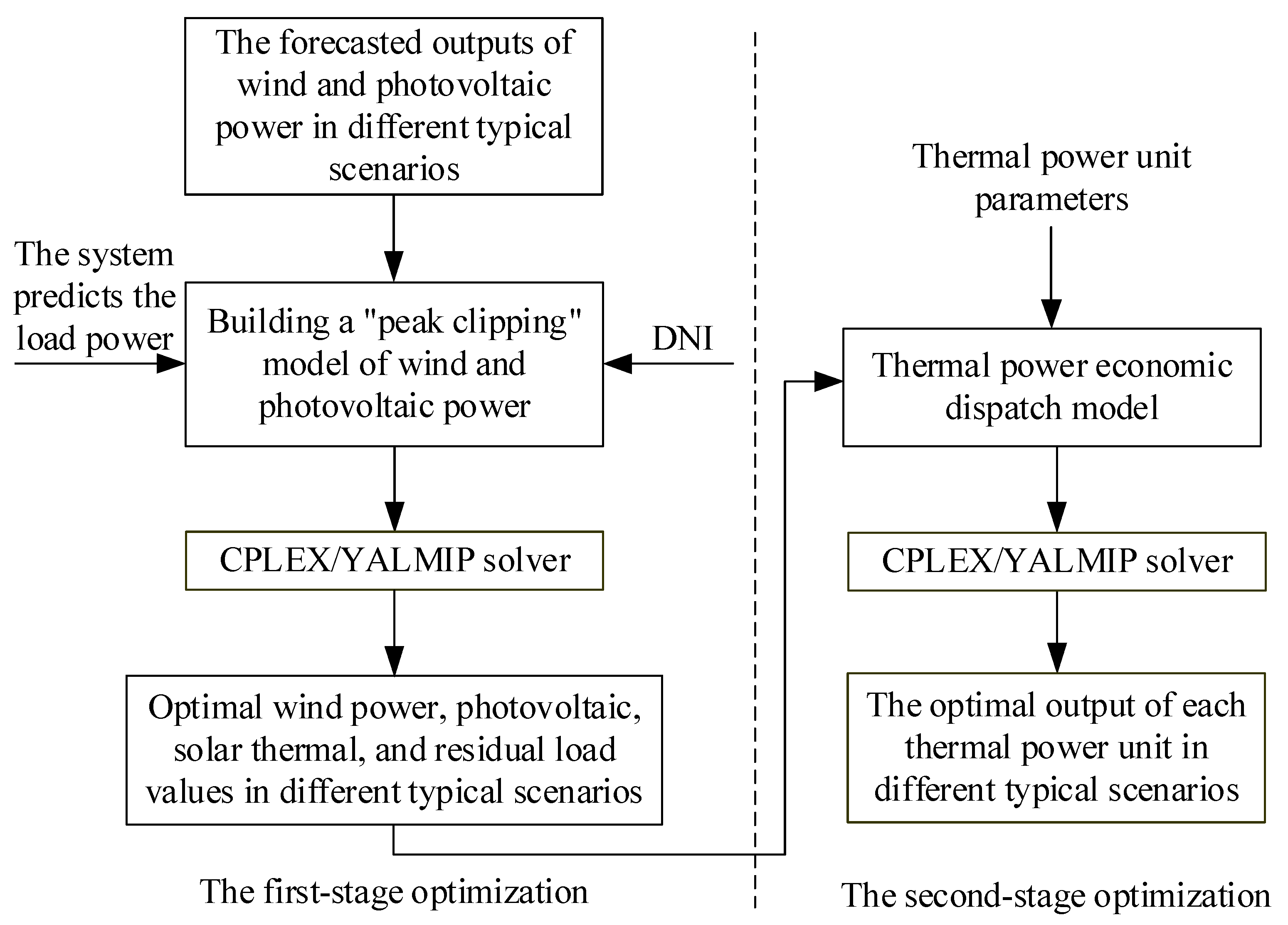
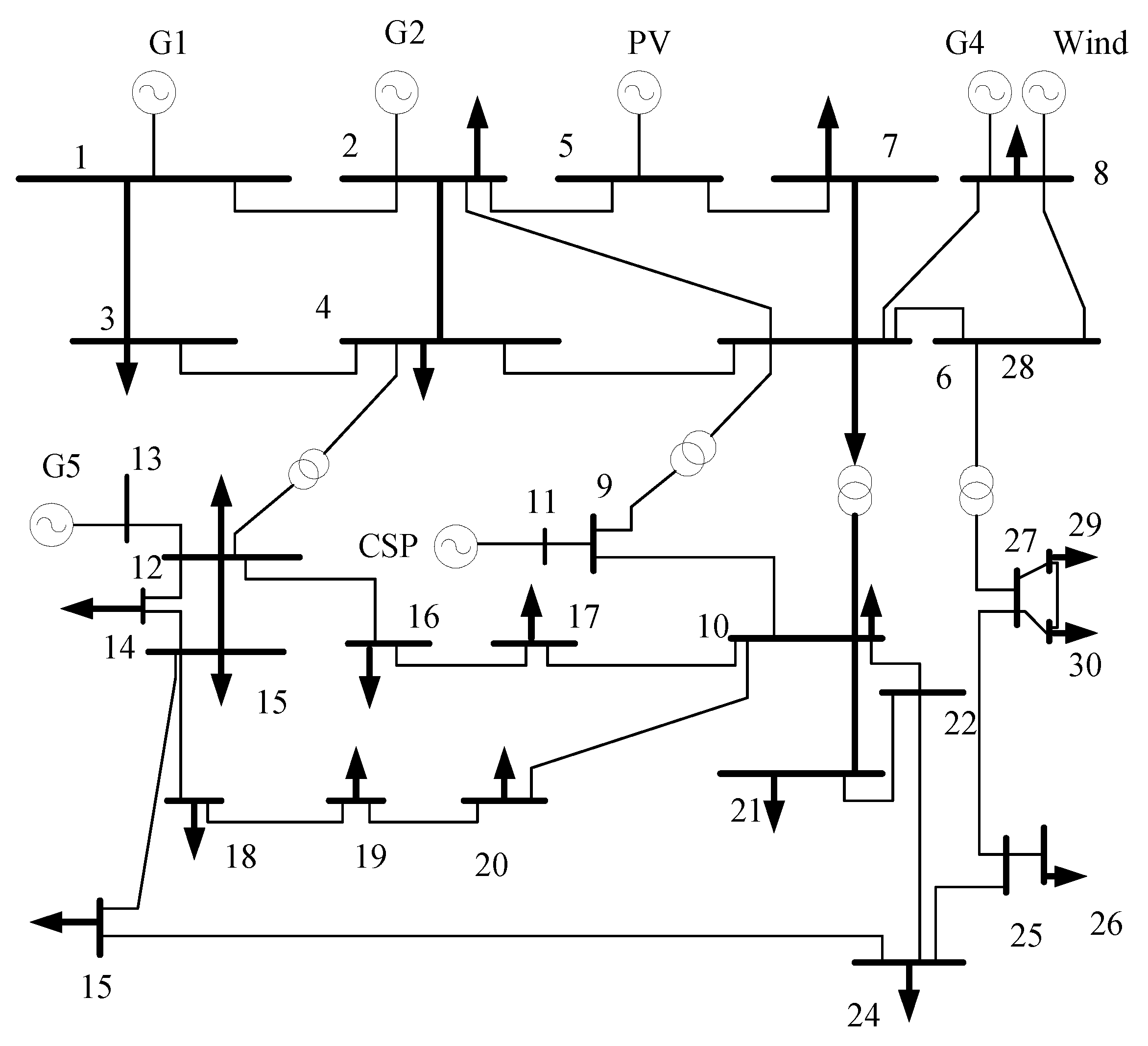
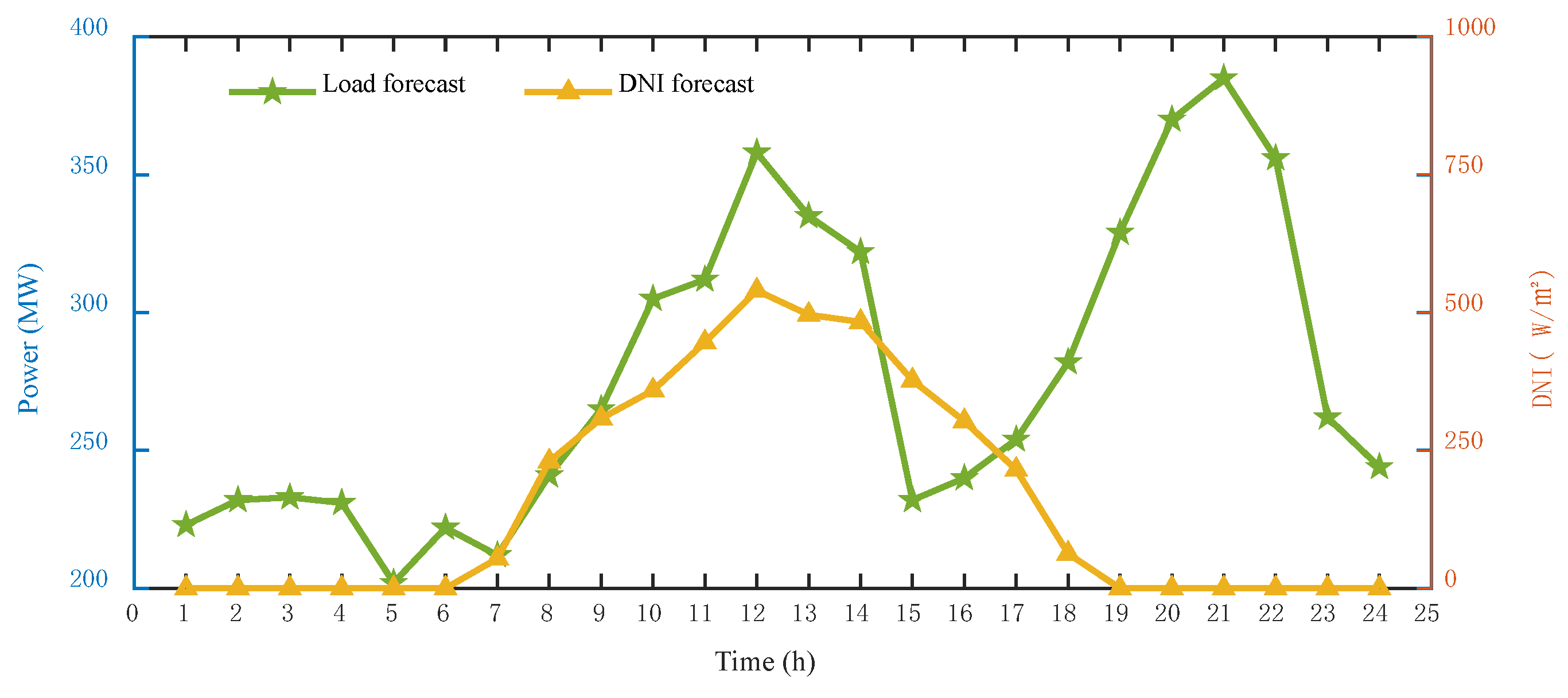




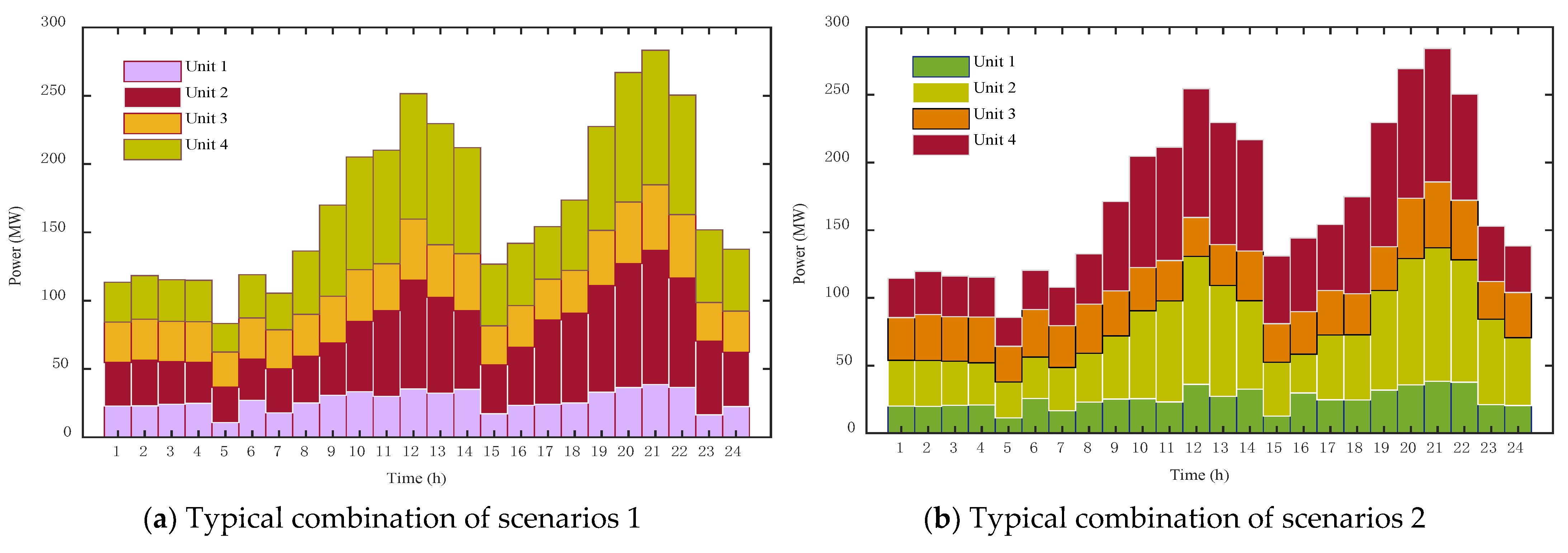
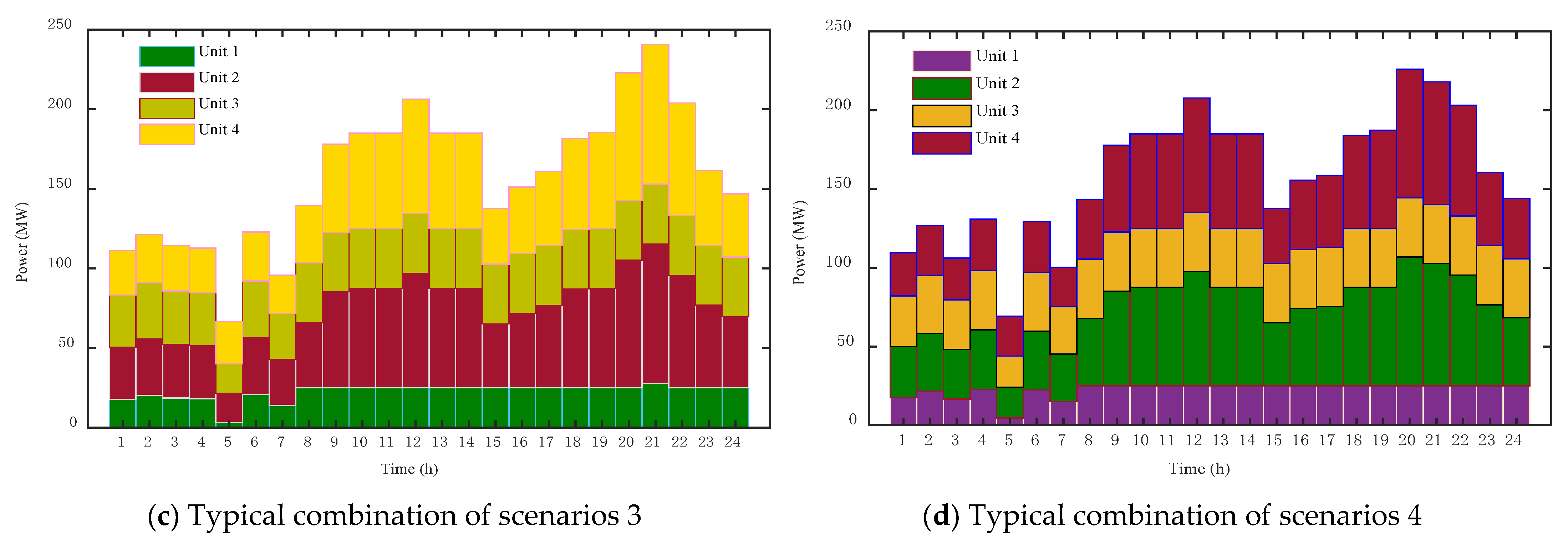
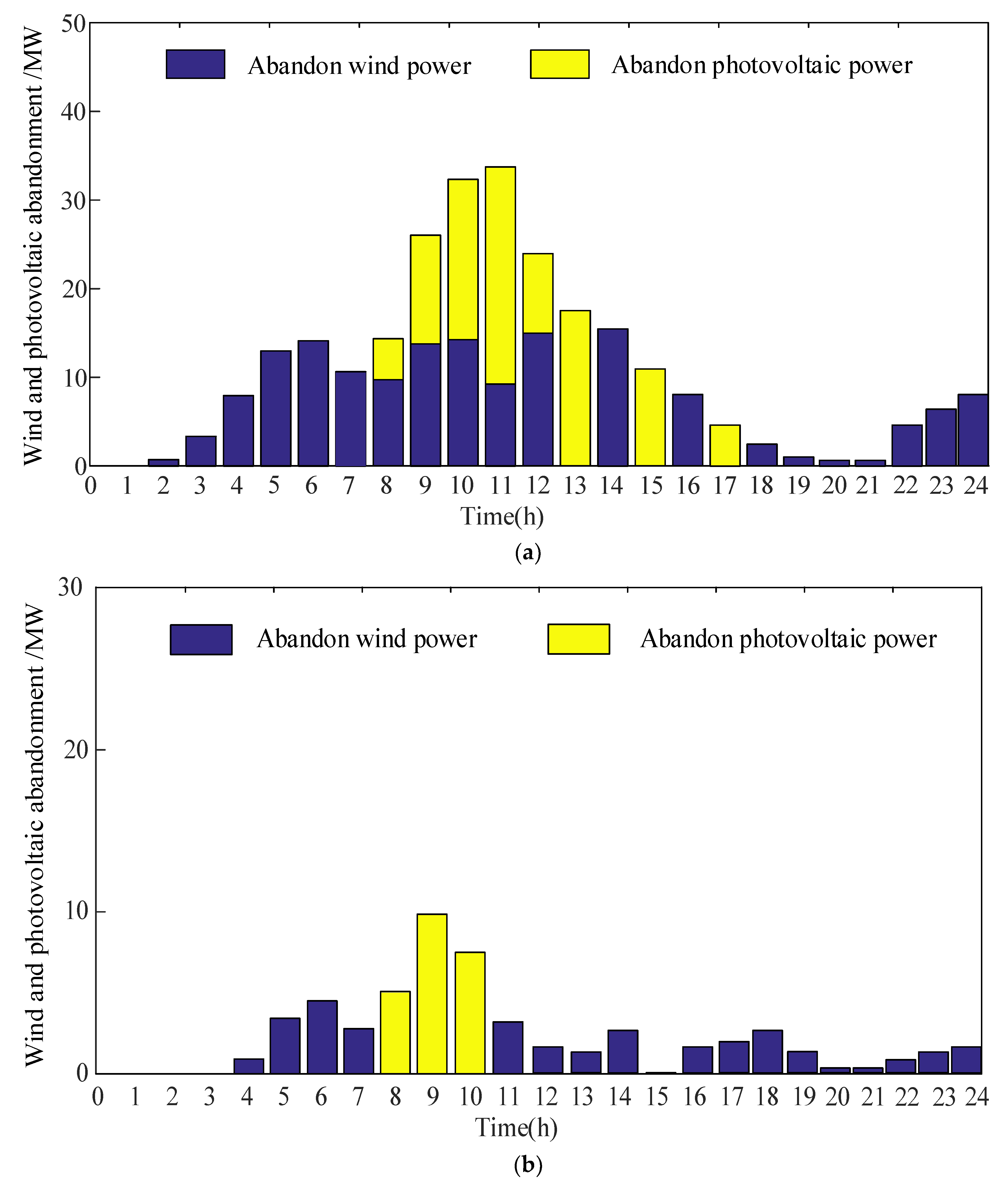

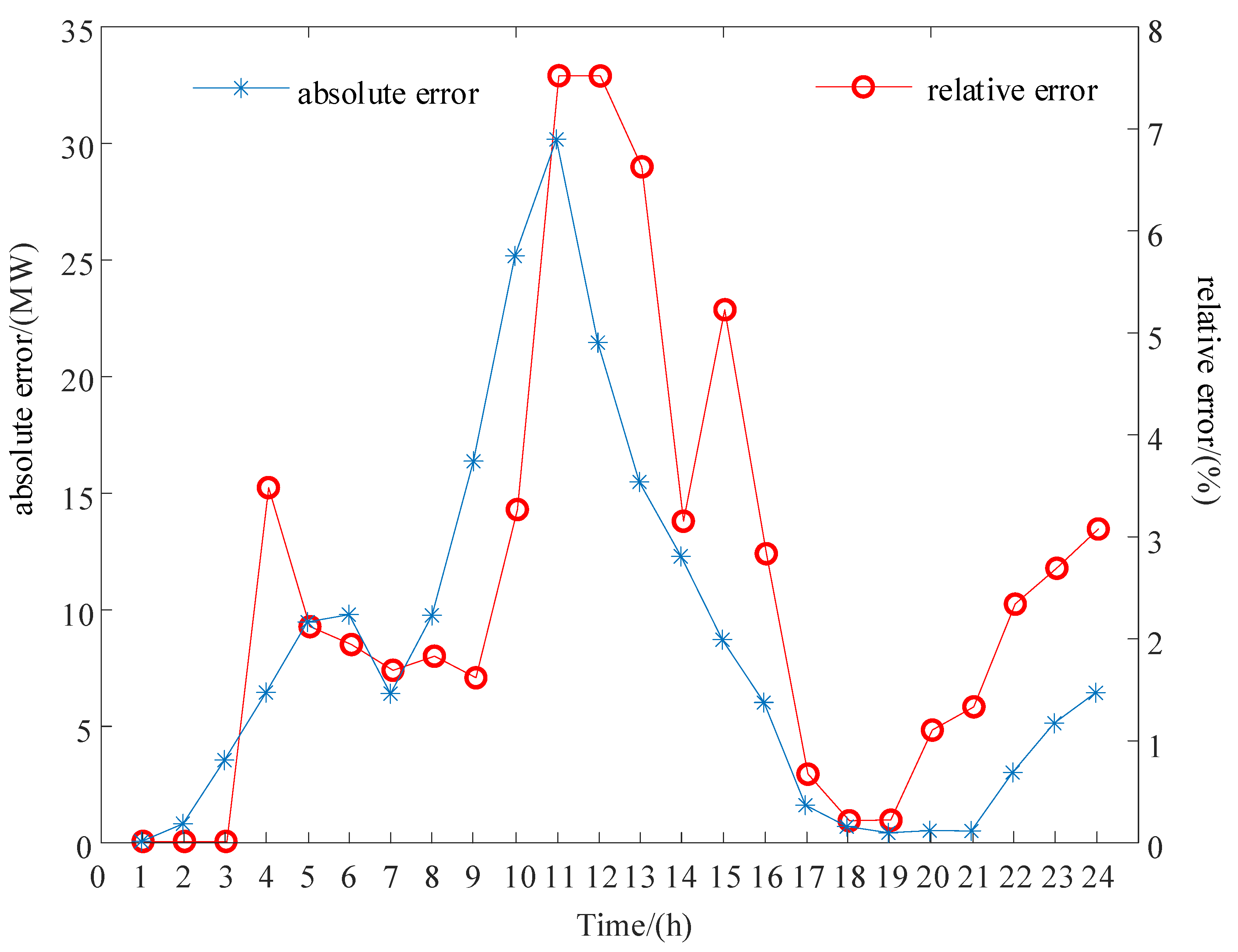
| Unit | Output Upper Limit/MW | Output Lower Limit/MW | Unit Ramp Rate/MW·h−1 | Efficiency of Fuel Cost | ||
|---|---|---|---|---|---|---|
| ai/¥·MW−2 | bi/¥·MW−1 | ci/¥ | ||||
| 1 | 40 | 10 | 30 | 0.3 | 0.27 | 13.7 |
| 2 | 100 | 25 | 30 | 1.4 | 0.26 | 14.5 |
| 3 | 50 | 25 | 40 | 6.1 | 0.28 | 6.35 |
| 4 | 100 | 20 | 40 | 0.8 | 0.27 | 14.1 |
| Operational Parameters of CSP Station | Value |
|---|---|
| Rated output power of CSP station/MW | 50 |
| Minimum output power of CSP station/MW | 10 |
| Climbing rate of CSP station/MW/h | 40 |
| Rate of heat release loss of TES/% | 0.57 |
| Thermal power conversion efficiency of CSP station/% | 0.45 |
| Maximum heat storage capacity/MWh | 1000 |
| Initial value of heat storage capacity of TES/MWh | 400 |
| Lower limit of TES/MWh | 100 |
| PV1 | PV2 | PV3 | PV4 | |
|---|---|---|---|---|
| WF1 | −0.9409 | −0.9427 | −0.9495 | −0.9353 |
| WF2 | −0.9428 | −0.9431 | −0.9491 | −0.9354 |
| WF3 | −0.9531 | −0.9502 | −0.9643 | −0.9441 |
| WF4 | −0.9451 | −0.9475 | −0.9522 | −0.9416 |
| Typical Combination of Scenarios | Residual Load Peak–valley Difference/MW | Abandoned Wind Quantity/MW | Abandoned Photovoltaic Quantity/MW | Thermal Power Operation Cost/yuan |
|---|---|---|---|---|
| 1 | 132.964 | 78.284 | 36.877 | 103,543.898 |
| 2 | 136.021 | 81.393 | 38.383 | 104,352.931 |
| 3 | 138.008 | 81.924 | 38.919 | 184,698.118 |
| 4 | 138.461 | 96.119 | 40.194 | 184,779.507 |
| Mode | Thermal Power Operation Cost/yuan | Abandoned Wind and Light Penalty Cost/yuan | Total Wind Curtailment and Light Abandonment Rate/% | Scheduling Cost/yuan |
|---|---|---|---|---|
| Mode 1 | 218,840.185 | 12,000 | 19.971 | 230,840.185 |
| Mode 2 | 238,231.046 | 16,996.924 | 25.849 | 255,227.9703 |
| Mode 3 | 103,543.898 | 11,516.142 | 17.682 | 115,060.040 |
Publisher’s Note: MDPI stays neutral with regard to jurisdictional claims in published maps and institutional affiliations. |
© 2022 by the authors. Licensee MDPI, Basel, Switzerland. This article is an open access article distributed under the terms and conditions of the Creative Commons Attribution (CC BY) license (https://creativecommons.org/licenses/by/4.0/).
Share and Cite
Xu, M.; Cui, Y.; Wang, T.; Zhang, Y.; Guo, Y.; Zhang, X. Optimal Dispatch of Wind Power, Photovoltaic Power, Concentrating Solar Power, and Thermal Power in Case of Uncertain Output. Energies 2022, 15, 8215. https://doi.org/10.3390/en15218215
Xu M, Cui Y, Wang T, Zhang Y, Guo Y, Zhang X. Optimal Dispatch of Wind Power, Photovoltaic Power, Concentrating Solar Power, and Thermal Power in Case of Uncertain Output. Energies. 2022; 15(21):8215. https://doi.org/10.3390/en15218215
Chicago/Turabian StyleXu, Min, Yan Cui, Tao Wang, Yaozhong Zhang, Yan Guo, and Xiaoying Zhang. 2022. "Optimal Dispatch of Wind Power, Photovoltaic Power, Concentrating Solar Power, and Thermal Power in Case of Uncertain Output" Energies 15, no. 21: 8215. https://doi.org/10.3390/en15218215
APA StyleXu, M., Cui, Y., Wang, T., Zhang, Y., Guo, Y., & Zhang, X. (2022). Optimal Dispatch of Wind Power, Photovoltaic Power, Concentrating Solar Power, and Thermal Power in Case of Uncertain Output. Energies, 15(21), 8215. https://doi.org/10.3390/en15218215





